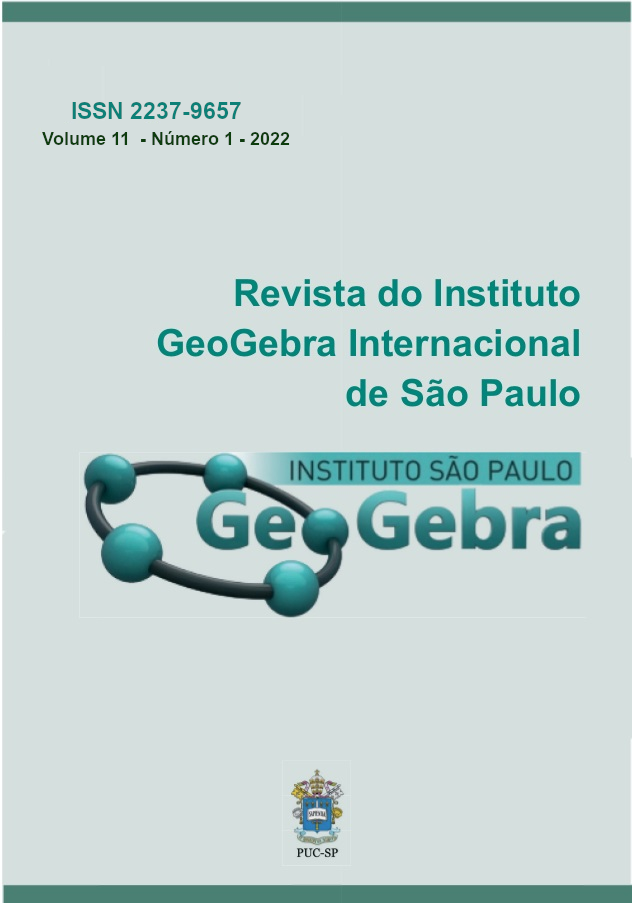GeoGebra Classroom, during confinement, in teaching and learning the properties of quadrilaterals
DOI:
https://doi.org/10.23925/2237-9657.2022.v11i1p118-136Keywords:
design-based research, online teaching and learning, geometry learning, educational technologie, GeoGebra ClassroomAbstract
This paper presents an online learning experience with the use of the GeoGebra Classroom, which occurred during the first period of confinement in Portugal, from March to June 2020, caused by the pandemic of COVID19. In addition to the researchers, two classes of 7th year of elementary school, of a secondary school participate in this study. Briefly, the characteristics inherent to the GeoGebra Classroom ecosystem are presented, describing the materials built and applied in the online class. The teaching and learning content focused on the construction and properties of the quadrilaterals. We will also analyze the course of the teaching experience carried out, reflecting on the virtuality’s of this online approach, comparing it with other classroom teaching situations. Finally, the results of this teaching experience will be discussed, pointing out its strengths and weaknesses, outlining some aspects to be taken care of in the development of similar future experiences.
References
Bottino, R. and Furinghetti, F. (1996). The Emerging of teachers’ conceptions of new subjects inserted into mathematics programs: The case of informatics. Educational Studies in Mathematics 30, 109–134.
Clements, D. H. (1999). Geometric and spatial thinking in young children. In J. V. Copley (Ed.), Mathematics in the early years (pp. 66–79). Reston, VA: National Council of Teachers of Mathematics.
Cobb, P. (2000). Conducting classroom teaching experiments in collaboration with teachers. In A. Kelly & R. Lesh (Eds.), Handbook of research design in mathematics and science education (pp. 307–334). Mahwah, NJ: Lawrence Erlbaum Associates, Inc.
Cobb, P. (2003). Investigating students’ reasoning about linear measurement as a paradigm case of design research. In M. Stephan, J. Bowers, P. Cobb, & K. Gravemeijer (Eds.), Supporting students’ development of measuring conceptions: Analyzing students’ learning in social context (pp. 1–16). Reston, VA: National Council of Teachers of Mathematics.
Danke, O. L. (1976). Investigación y comunicación, en C. Fernández—Collado y G.L. Dankhe (Eds): “La comunicación humana: ciencia social”. México, D.F: McGrawHill de México. Capítulo 13, pp. 385— 454.
Denbel, D. G. (2015). Students’ learning experiences when using a dynamic geometry software tool in a geometry lesson at secondary school in Ethiopia. Journal of Education and Practice, 6(1), 23–38.
Dos Santos, J., e Trocado, A.- (2016). GeoGebra as a learning Mathematical Environment. Revista do Instituto GeoGebra Internacional de São Paulo. ISSN 2237-9657, 5(1), 05-22. https://revistas.pucsp.br/IGISP/article/viewFile/26795/19963
Drijvers, P., & Trouche, L. (2008). From artifacts to instruments: A theoretical framework behind the orchestra metaphor. In: G. W. Blume & M. K. Heid (Eds.), Research on technology and the teaching and learning of mathematics (pp. 363–392). Charlotte, NC: Information Age.
Gawlick, Th. (2002). On Dynamic Geometry Software in the Regular Classroom. ZDM, 34(3), 85-92.
Hohenwarter, J., Hohenwarter, M., & Lavicza, Z. (2008). Introducing dynamic mathematics software to secondary school teachers: The case of geogebra. Journal of Computers in Mathematics and Science Teaching, 28 (2), 135–146.
Hohenwarter, M. (2002). GeoGebra-a software system for dynamic geometry and algebra in the plane. Unpublished master’s thesis, University of Salzburg, Austria.
Hollebrands, K. F. (2003). High school students’ understandings of geometric transformations in the context of a technological environment. Journal of Mathematical Behavior, 22(1), 55-72.
Jones, K. (2002). Research on the use of dynamic geometry software: implications for the classroom. MicroMath, 18(3), 18-20.
Kosko, K. W., Rougee, A., & Herbst, P. (2014). What actions do teachers envision when asked to facilitate mathematical argumentation in the classroom? Mathematics Education Research Journal, 26(3), 459– 476.
Laborde,C.(1999).Technology used as a tool for mediating knowledge in the teaching of mathematics: the case of Cabri-geometry, in Plenary lecture at Asian Technology Conference in Mathematics.
Leung, A. (2015). Discernment and reasoning in dynamic geometry environments. In Selected regular lectures from the 12th international congress on mathematical education (pp. 451-469). Springer, Cham.
MEC (2018). Aprendizagens Essenciais, Articulação com o Perfil dos Alunos - Matemática - Ensino Básico, 3.º ciclo, Matemática, 7.° ano. http://www.dge.mec.pt/sites/default/files/Curriculo/Aprendizagens_Essenciais/3_ciclo/matematica_3c_7a_ff_18julho_rev.pdf
NCTM (National Council of Teachers of Mathematics), (2000). Principles and Standards for School Mathematics. Reston, VA: Author.
Plomp, T. (2013). Educational design research: An introduction. In T. Plomp & N. Nieveen (Eds.), Educational design research - Part A: An Introduction (pp. 10-51). Enschede, the Netherlands: SLO.
Ruthven, K., Hennessy, S., & Deaney, R. (2008). Constructions of dynamic geometry: A study of the interpretative flexibility of educational software in classroom practice. Computers and Education, 51(1), 297-317.
Smith, M. S., & Stein, M. K. (1998). Selecting and creating mathematical tasks: from research to practice. Mathematics Teaching in the Middle School, 3(5), 344-350.
Swan, M. (2007). The impact of task-based professional development on teachers‟ practices and beliefs: A design research study. Journal of Mathematics Education, 10, 217-237.
Wiest, L. R. (2001). The role of computers in mathematics teaching and learning, Computers in the Schools, 17(1-2), 41-55.
Yackel, E., e Cobb, P. (1996). Sociomathematical norms, argumentation, and autonomy in mathematics. Journal for Research in Mathematics Education, 27(4), 458–477.
Zöchbauer, J., & Hohenwarter, M. (2020, February). Developing a collaboration tool to give every student a voice in a classroom discussion. In Seventh ERME Topic Conference on Language in the Mathematics Classroom. https://hal.archives-ouvertes.fr/hal-02970629/document
Materiais
Dos Santos, J.M. e Reis, I.M.S. (2020). Vídeos de apoio às tarefas. https://www.youtube.com/channel/UC8OBwSN3Cvo1Zr0X27Fulhw/videos
Downloads
Published
How to Cite
Issue
Section
License
Copyright (c) 2022 Revista do Instituto GeoGebra Internacional de São Paulo

This work is licensed under a Creative Commons Attribution 4.0 International License.
Submission, processing, and publication of articles sent to the journal and registration of the DOI at Crossref is free of charge.
Authors retain their copyright and grant the journal the right of first publication of their article, which is simultaneously licensed under a Creative Commons - Attribution 4.0 International license CC BY that allows others to share the article by acknowledging its authorship and initial publication by the journal.
The GeoGebra journal encourages its authors to register their work with information and communication management systems aimed at researchers, such as Academia.edu, Mendeley, ResearchGate, etc.


 10.23925
10.23925
